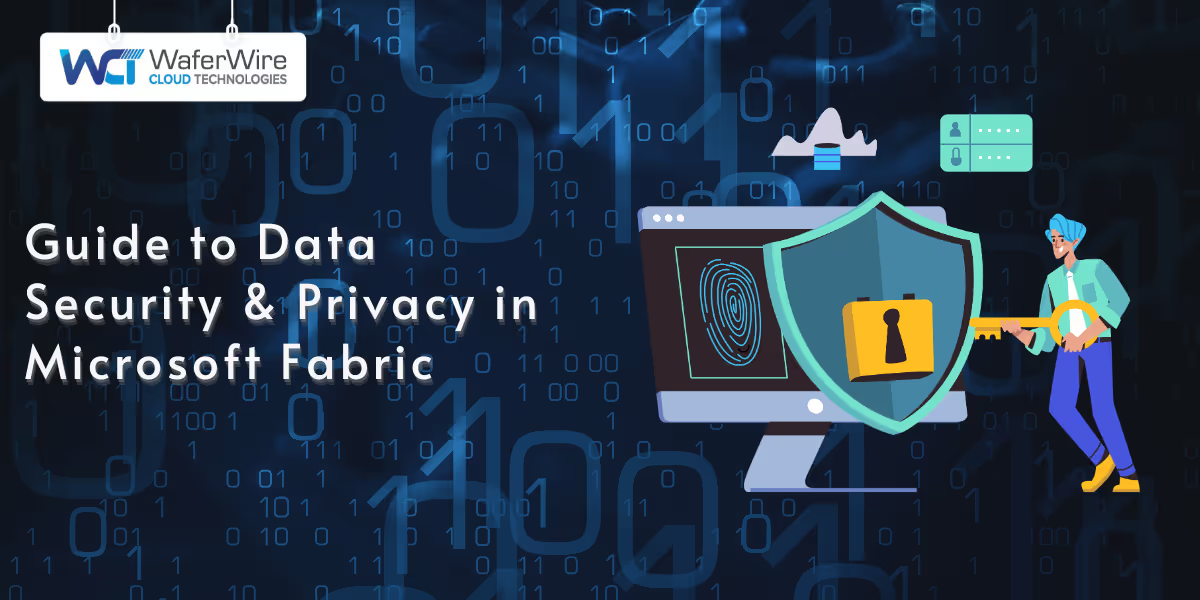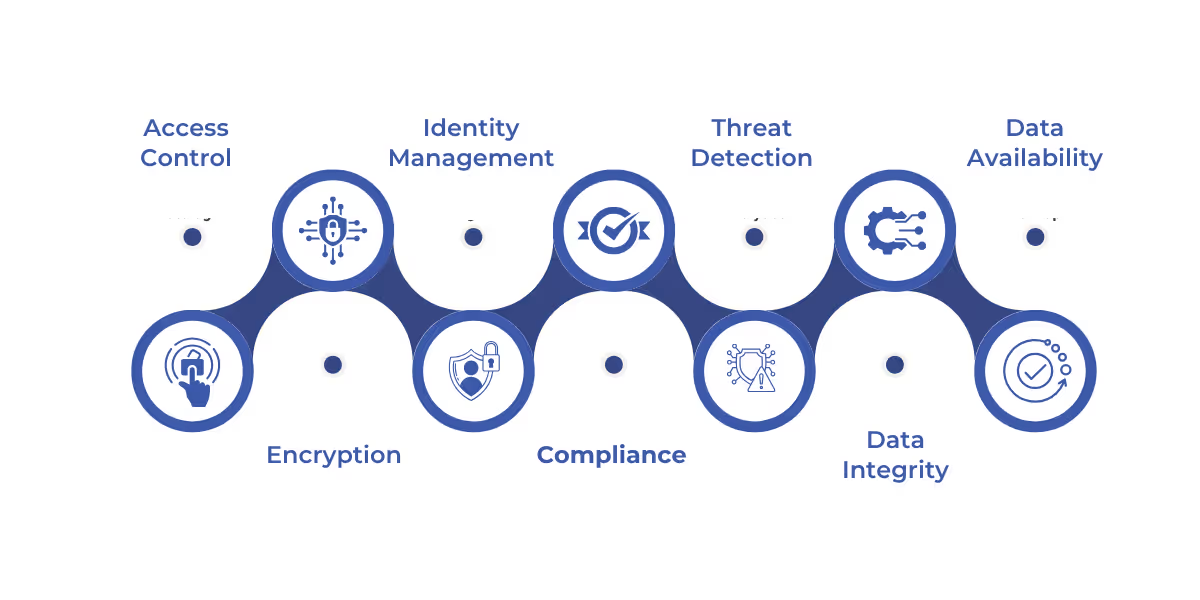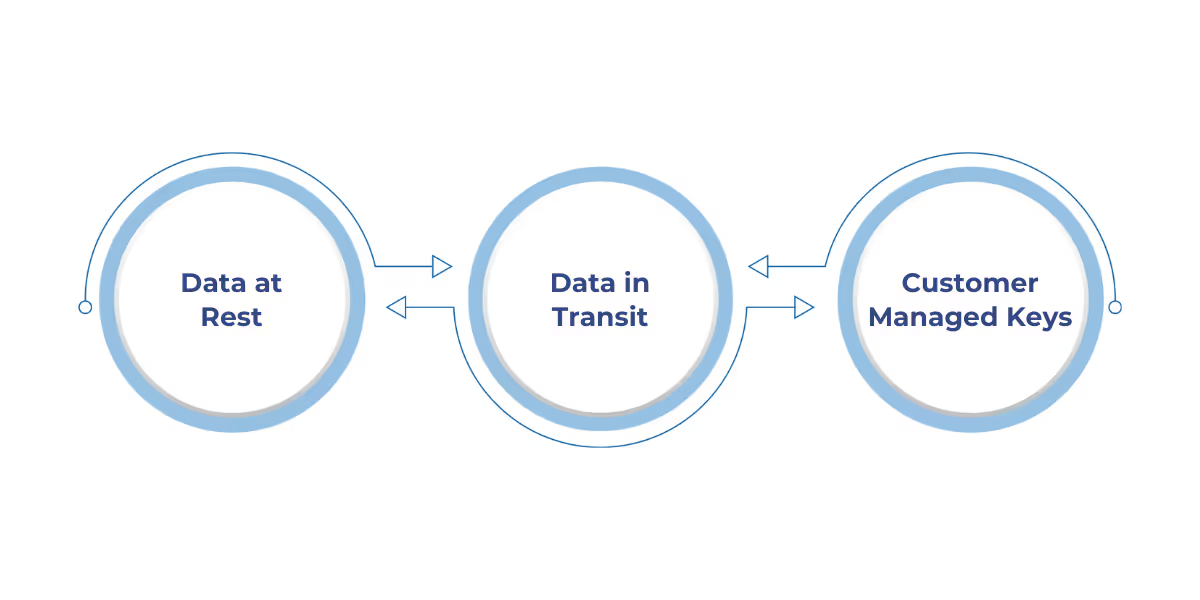

Microsoft Fabric, as a Software-as-a-Service (SaaS) analytics platform, embeds enterprise-grade security directly into the architecture. Its design ensures strict control over access, encryption, compliance, and data protection across multi-tenant environments.

Data security in Microsoft Fabric ensures the protection of data from unauthorized access, alteration, or loss, maintaining its confidentiality, integrity, and availability.
It employs encryption, access control, and compliance measures to safeguard both structured and unstructured data.
To ensure that only authorized users have access to critical resources, Microsoft Fabric incorporates a robust identity and access management framework.
IAM in Microsoft Fabric governs who can access resources and under what conditions, using centralized identity controls and policy enforcement.
All access to Fabric is authenticated via Entra ID, providing centralized identity and access management across devices and networks. This ensures consistent enforcement of login policies and session security.
MFA policies can be enforced through Conditional Access to require two or more verification methods. This prevents unauthorized access from compromised credentials, especially in sensitive environments like R&D and finance.
Fabric workspaces use granular roles (Admin, Member, Contributor, Viewer) to restrict access by role. Permissions are scoped to workspace items, and user privileges limit SQL/DAX queries.
To further safeguard data, Microsoft Fabric employs advanced network security and access controls to manage both internal and external data traffic securely.
Fabric secures all internal and external data traffic using network isolation, private connectivity, and conditional access mechanisms.
Inbound Security:
Outbound Security:
Also Read: Azure Cloud Modernization Strategies for the Future
With encryption being a cornerstone of data protection, Microsoft Fabric ensures that all data, both at rest and in transit, is securely encrypted using industry-leading protocols.

Microsoft Fabric encrypts data both at rest and in transit using enterprise-grade standards, with optional customer-managed key controls.
In addition to encryption, Microsoft Fabric integrates comprehensive governance tools that enforce compliance with global data privacy regulations and enhance data management.
Fabric implements layered governance through sensitivity labels, policy-based controls, and data access scoping to support compliance with global data regulations.
Microsoft Fabric also uses real-time monitoring and automated threat detection to ensure the security of all data operations across the platform.
Microsoft Fabric integrates monitoring and automated threat response capabilities to maintain operational security across workloads.
Ensuring the continuity of operations, Microsoft Fabric includes built-in resiliency and data recovery features to minimize downtime in the event of a disaster.
Fabric ensures high availability and data recoverability through geo-redundant storage and infrastructure resilience features.
Finally, Microsoft Fabric offers detailed governance and administrative controls, providing the flexibility to manage security policies and monitor usage efficiently.
Administrative capabilities in Fabric allow policy delegation, usage monitoring, and organizational security posture management.
WaferWire helps businesses optimize cloud infrastructure, implement efficient strategies, and use data analytics to enhance operations and growth. Here's how we can help:
Whether you're a large enterprise or a smaller business, WaferWire provides solutions tailored to your specific needs. We work with industries such as retail, manufacturing, financial services, and utilities.
WaferWire offers full support from strategy development to implementation, delivering practical solutions that drive results. Contact us to enhance your business operations.
Microsoft Fabric prioritizes your data security with encryption, access control, and real-time threat detection. By incorporating identity management, RBAC, and global compliance, it ensures your data is always protected and secure.
Ongoing monitoring and adherence to best practices are key to maintaining this security. By using these features effectively, businesses can safeguard their data and meet compliance requirements.
At WaferWire, we assist with the implementation and optimization of Microsoft Fabric’s security features. Contact us today for help with setup, compliance, and custom configurations to secure your data.
Q: How does Microsoft Fabric ensure secure data transfer?
A: Microsoft Fabric encrypts all data in transit using TLS 1.2 or higher, securing the communication channels between clients and servers. This encryption ensures that data cannot be intercepted or tampered with during transfer. It helps protect sensitive business information in transit across networks.
Q: Can I control access to individual data items in Microsoft Fabric?
A: Yes, Microsoft Fabric allows you to control access at a granular level with row-level security (RLS), column-level security (CLS), and object-level security (OLS). These controls enable you to define who can access specific data based on user roles and permissions. This ensures sensitive data is only accessible to authorized users.
Q: Does Microsoft Fabric support hybrid cloud environments?
A: Microsoft Fabric supports hybrid cloud deployments, enabling integration with on-premises systems and other cloud services. It uses secure data gateways and private endpoints to connect on-premises data sources to the cloud securely. This flexibility allows businesses to combine cloud and on-premises resources seamlessly.
Q: How does Microsoft Fabric handle regulatory compliance?
A: Microsoft Fabric adheres to global standards such as GDPR, HIPAA, and more, ensuring data privacy and security. It provides built-in compliance features, certifications, and tools to help organizations meet regulatory requirements. This helps businesses maintain data protection while operating in regulated industries.
Q: Can Microsoft Fabric scale to meet growing business needs?
A: Yes, Microsoft Fabric is designed to scale dynamically based on business requirements. It offers flexible cloud infrastructure that adjusts to increased data volumes and processing demands. This scalability ensures that businesses can grow without worrying about infrastructure limitations.

